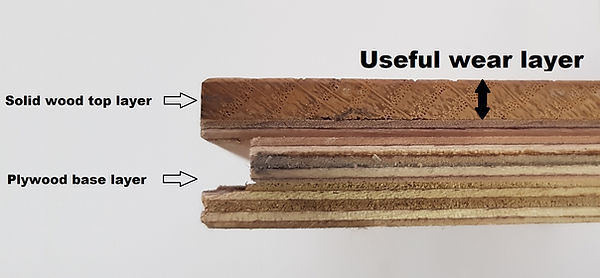Sales - sales@derrington.co.za
Adele - 083 326 7897 - adele@derrington.co.za
Khalid - 074 051 9317 - khalid@derrington.co.za
Technical
Neil - 082 900 3343 - neil@derrington.co.za
Solid vs Engineered Flooring
So what's the difference?
We often get asked what the difference is between solid wood flooring and engineered flooring (and laminate is often brought up as well).
Solid Wood Flooring
This is flooring made up entirely of solid wood - the same piece all the way through, and always supplied as a tongue and groove floor plank or as solid parquet. In almost all cases the flooring will need to be sanded and sealed on site after installation.
Engineered Wood Flooring
This is flooring made up with a surface layer of real wood onto a cross-ply base (in some cases the base can be HDF - High Density Fiberboard). The top layer can vary in thickness from 1mm to 6mm - the thicker the top layer the longer the expected life of the floor will be. Engineered wooden floors are available both as tongue and groove floor and click-lock planks. The can be factory pre-finished or come pre-sanded, requiring finishing on site or off-site when necessary.
So which one is better?
Ah, the million dollar question! As in most things, it just depends.....in most cases the engineered floor board would be your best option, but not always.
-
A thin top wear layer on an engineered won't last as long as it cannot be sanded and sealed at all, but would be more affordable.
-
Engineered floor boards are not as structurally strong as a solid board - this is often irrelevant as the flooring is normally installed onto a sub-floor that has the necessary strength.
-
Solid planks are not as stable as an engineered plank - the cross-ply construction of an engineered floor board will make it more dimensionally stable - expansion gaps can be reduced, and larger areas can be covered without risk of floor failures with an engineered floor.
-
Waste - normally on a solid wood floor only the top third or so of the plank can be considered the "useful wear layer", once a floor has been sanded down to the locking joint or top of the groove, it will be at the end of it's life. Using a faster growing or more commonly available timber to construct the base layer means you can get more flooring coverage per tree on the top layer with the effectively the same life as a solid plank.
-
The look, feel and wear - on an engineered floor with a top layer thicker than 2mm it is impossible to see any difference to a solid wood plank, and the wear and feel of the two floors would be the same.

